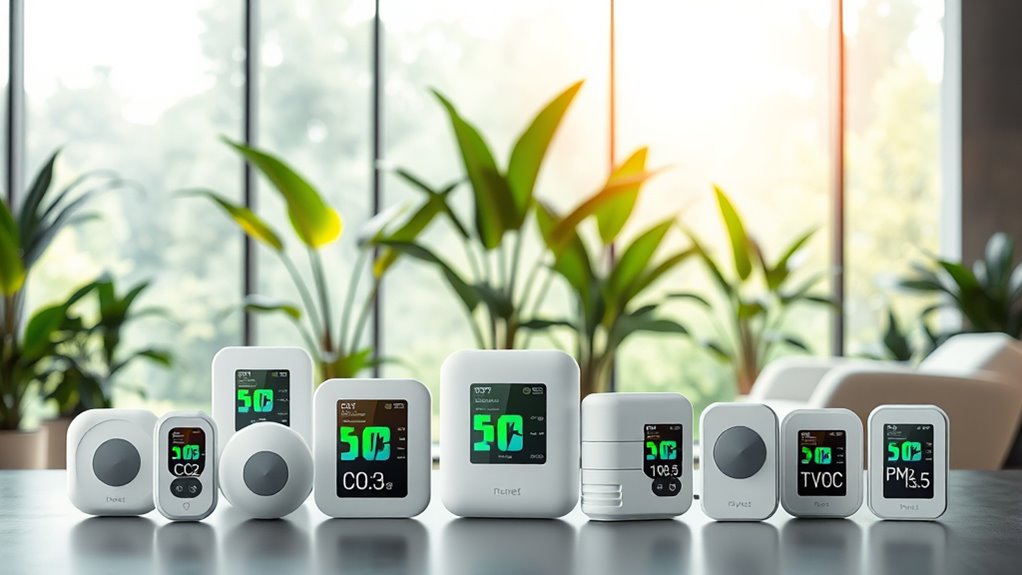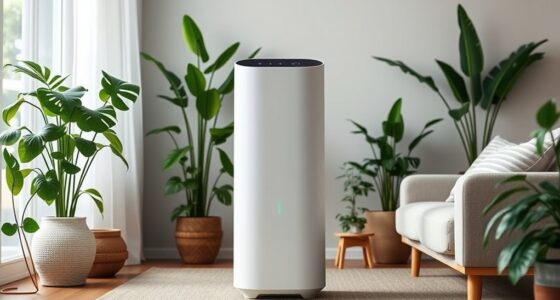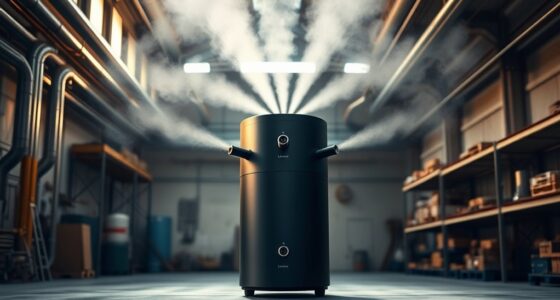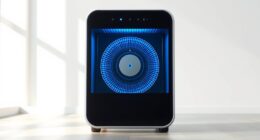If you’re looking for the top air quality sensors in 2025, I recommend devices that measure CO₂, PM2.5, and TVOC accurately, with user-friendly displays and smart connectivity. The models I’ve seen include features like real-time alerts, long-term data tracking, and easy calibration. Many are suitable for homes or offices. Keep exploring to discover which options best fit your needs for a healthier indoor environment now and in the future.
Key Takeaways
- Top sensors feature multi-pollutant detection: CO₂, PM2.5, and TVOC, ensuring comprehensive indoor air quality monitoring.
- Devices offer high-precision sensors with real-time data, alerts, and user-friendly interfaces for easy operation.
- Connectivity options like Wi-Fi and smartphone apps enable remote monitoring, data analysis, and long-term trend tracking.
- Portable and fixed designs cater to various environments, with rechargeable power options for flexibility and convenience.
- Advanced models incorporate color-coded visual alerts, voice notifications, and smart home integrations for proactive air quality management.
Bonoch 16-in-1 Indoor Air Quality Monitor with 7 Display and AQI Alerts

If you’re serious about monitoring your indoor air quality, the Bonoch 16-in-1 Indoor Air Quality Monitor is an excellent choice. It features a large, 7-inch high-definition LED display with adjustable brightness, making real-time data easy to read at a glance. The device tracks nine key parameters, including CO2, PM2.5, TVOC, formaldehyde, temperature, and humidity, providing detailed insights. With seven customizable AQI alert alarms, it keeps you proactively informed about air quality fluctuations. Its high-precision sensors detect even minor changes, ensuring accurate readings. Overall, this monitor offers user-friendly controls and reliable alerts to help you maintain a healthier indoor environment.
Best For: Homeowners and health-conscious individuals seeking comprehensive, real-time indoor air quality monitoring with customizable alerts.
Pros:
- Measures nine essential air parameters for thorough indoor air quality assessment
- Features a large, adjustable 7-inch high-definition LED display for easy reading
- Equipped with high-precision sensors for accurate detection of pollutants and environmental changes
Cons:
- External sensors require careful handling to maintain accuracy and avoid contamination
- The device may be more expensive than basic air quality monitors due to its advanced features
- Setup and customization might be overwhelming for users unfamiliar with air quality technology
9-in-1 Indoor Air Quality Monitor with Large Display and Voice Alerts
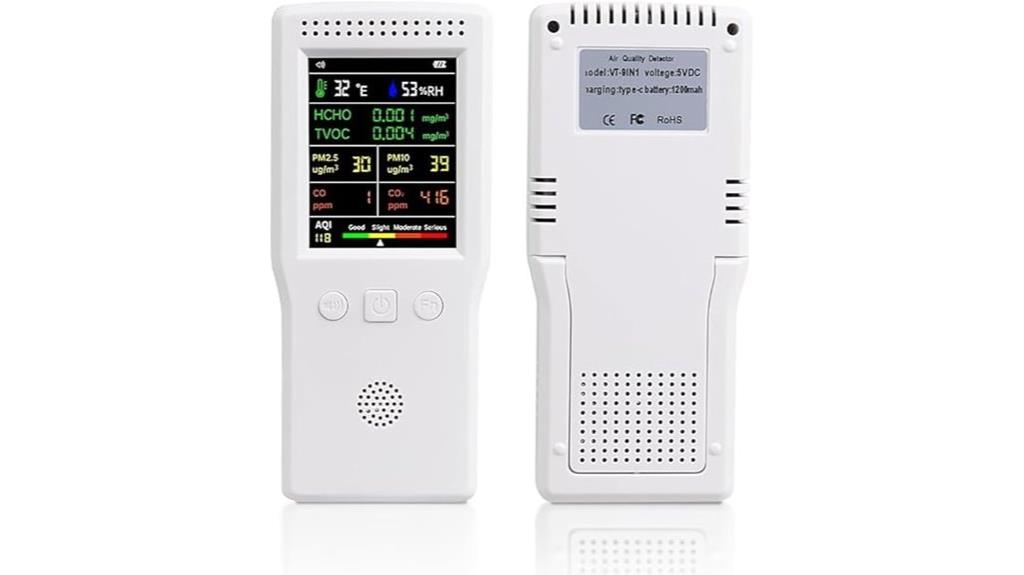
The in-1 Indoor Air Quality Monitor stands out for its large, easy-to-read display and clear voice alerts, making it an excellent choice for anyone who wants real-time updates on their indoor environment without fussing with complicated setups. It measures PM2.5, CO₂, formaldehyde, TVOC, humidity, and temperature with high accuracy, thanks to advanced sensors. The dual display and voice alerts help me quickly understand air quality changes and respond promptly. It’s simple to use—just turn it on, and it starts measuring immediately. Its portability and long battery life mean I can monitor multiple rooms easily, making my indoor air safer and healthier effortlessly.
Best For: those seeking an easy-to-use, portable indoor air quality monitor with real-time alerts and comprehensive pollutant measurement capabilities.
Pros:
- Large, easy-to-read display and clear voice alerts for quick understanding of air quality.
- Measures multiple pollutants including PM2.5, CO₂, formaldehyde, TVOC, humidity, and temperature with high accuracy.
- Plug-and-play design with long battery life, suitable for use across various rooms without complex setup.
Cons:
- Cannot calibrate CO₂ readings, which may affect measurement accuracy over time.
- Instruction manual is often considered unclear and difficult to understand.
- Some users report limited customization options and lack of app connectivity.
9-in-1 Indoor Air Quality Monitor
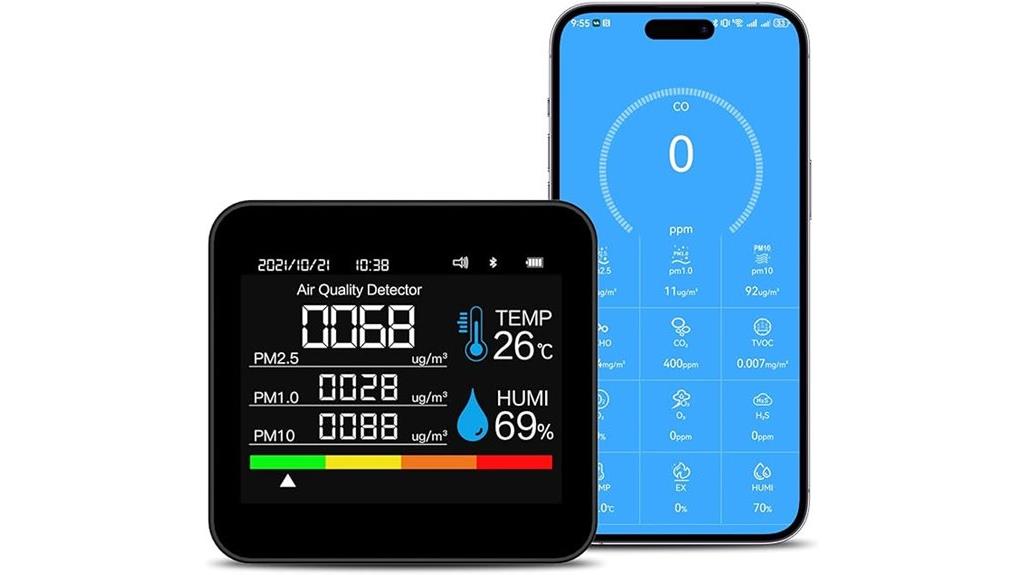
The 9-in-1 Indoor Air Quality Monitor by MEIMOUSE is an excellent choice for anyone seeking all-inclusive and real-time data on air quality in their home, office, or school. It detects PM1.0, PM2.5, PM10, CO₂, CO, TVOC, formaldehyde (HCHO), temperature, and humidity, offering a comprehensive view of indoor air conditions. Its bright display and simple setup make it accessible without professional help. I’ve found it effective for monitoring pollutants during daily activities like cooking or airing out rooms. Although it requires plugging in for continuous use, users appreciate its accuracy, ease of use, and ability to identify pollution sources, making it a reliable indoor air quality tool.
Best For: those seeking a comprehensive, real-time indoor air quality monitor for homes, offices, schools, or hotels without professional installation.
Pros:
- Provides all-in-one monitoring of PM levels, gases, VOCs, formaldehyde, temperature, and humidity for complete air quality assessment.
- Easy to set up and operate with a bright, clear display suitable for users without technical expertise.
- Accurate and quick readings that help identify pollution sources and support healthy environment management.
Cons:
- Short power cord limits placement options near vents or outlets, requiring frequent plugging in for continuous use.
- Minor inaccuracies in temperature and humidity readings may occur, with some discrepancies up to 6°F and 8%.
- Instructions can be difficult to read due to small print, and the device’s design could benefit from features like repositioned power ports.
8-in-1 Indoor Air Quality Monitor
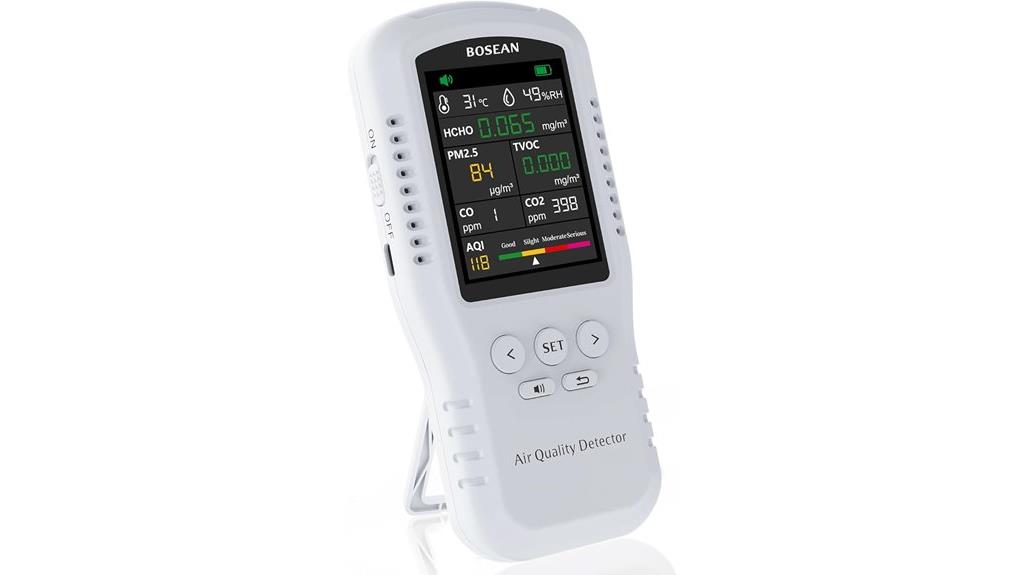
An 8-in-1 Indoor Air Quality Monitor stands out as an ideal choice for families and individuals who want all-encompassing health protection at home or in the office. It measures eight key data points: formaldehyde, CO, CO₂, AQI, TVOC, PM2.5, temperature, and humidity, providing extensive air quality insights. Its user-friendly LCD screen indicates safety levels with clear color codes, and simple operation makes it accessible for everyone. Powered by a rechargeable battery, it alerts you with sounds and colors when air quality declines. Designed for indoor use, it’s perfect for various spaces, ensuring you stay informed and safe year-round.
Best For: families, homeowners, and office users seeking comprehensive indoor air quality monitoring to ensure a healthy environment.
Pros:
- Measures 8 critical air quality parameters for thorough monitoring
- User-friendly LCD display with clear color indicators and simple operation
- Built-in memory records recent 8-hour data, supporting easy tracking and analysis
Cons:
- Requires placement in ventilated indoor spaces for at least 1 hour before use for accurate readings
- Battery life lasts only 6-8 hours, which may necessitate frequent recharging during extended use
- Designed specifically for indoor environments; not suitable for outdoor air quality assessment
14-in-1 Air Quality Monitor with Temperature and Humidity Sensors
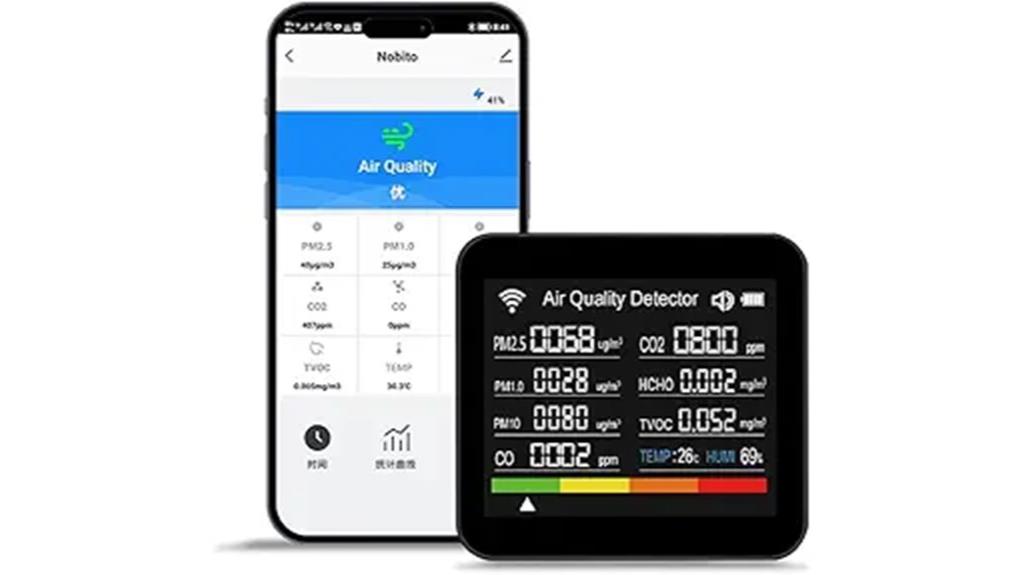
If you want a detailed indoor air quality solution that also monitors temperature and humidity, the 14-in-1 Air Quality Monitor is an excellent choice. It detects PM1.0, PM2.5, PM10, CO2, CO, TVOC, and HCHO, plus temperature and humidity, offering extensive data. The device features a 2.8-inch color TFT display for real-time and historical readings, with easy-to-read visuals. It connects to your smartphone for remote monitoring, alerts, and trend tracking. Compact, lightweight, and powered by a rechargeable battery, it’s suitable for homes, offices, or public spaces. Its multifunctionality helps you maintain healthier indoor environments with reliable, accessible data.
Best For: individuals seeking an affordable, all-in-one indoor air quality monitor with temperature and humidity tracking for home or office environments.
Pros:
- Provides comprehensive readings including PM, gases, temperature, and humidity in one device
- Features a bright, easy-to-read 2.8-inch color TFT display with real-time and historical data
- Connects to smartphones for remote monitoring, alerts, and trend analysis
Cons:
- Short battery life (~6 hours) requires frequent charging or external power sources
- Occasional display errors and sensor inconsistencies reported by users
- Limited manual instructions and low-resolution manuals can hinder user experience
Qingping Air Quality Monitor Gen 2, Indoor Air Quality Tester with PM2.5, CO2, PM10, Noise, Temp & Humidity
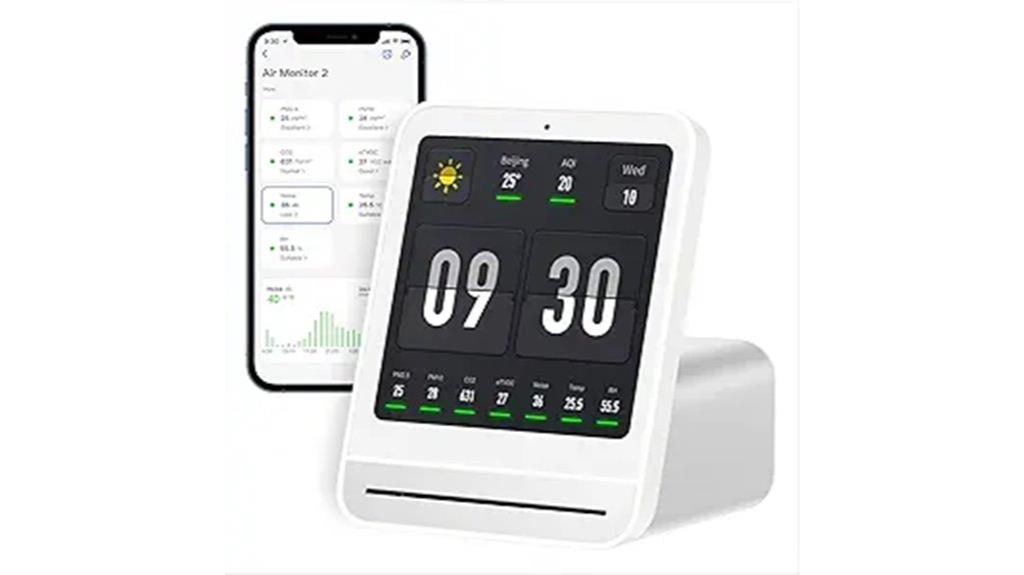
For anyone seeking thorough indoor air quality monitoring, the Qingping Air Quality Monitor Gen 2 stands out with its ability to measure seven key metrics in real time. It tracks temperature, humidity, CO₂, PM2.5, PM10, noise levels, and eTVOC, all displayed clearly on a high-resolution 4-inch touchscreen. The device uses accurate sensors with replaceable components, ensuring long-term reliability. Its Wi-Fi connectivity allows remote monitoring via the Qingping+ app, where you can view, export, and analyze historical data. Compact and sleek, it’s perfect for bedrooms and smart homes, offering practical features like alarms and automatic brightness adjustment for a seamless user experience.
Best For: individuals seeking comprehensive and reliable indoor air quality monitoring with real-time data and smart connectivity features.
Pros:
- Provides accurate, real-time measurements of seven key indoor air quality metrics including PM2.5, CO2, and noise levels.
- Features a high-resolution touchscreen display with intuitive controls and automatic brightness adjustment.
- Supports remote monitoring, data export, and analysis via the Qingping+ app for long-term tracking.
Cons:
- Operates only up to three hours on a full battery charge, requiring frequent connection to USB power for continuous use.
- Does not measure formaldehyde or other volatile organic compounds beyond eTVOC.
- Firmware updates and sensor replacements may require some technical familiarity.
Air Quality Monitor Indoor with WiFi and App Control
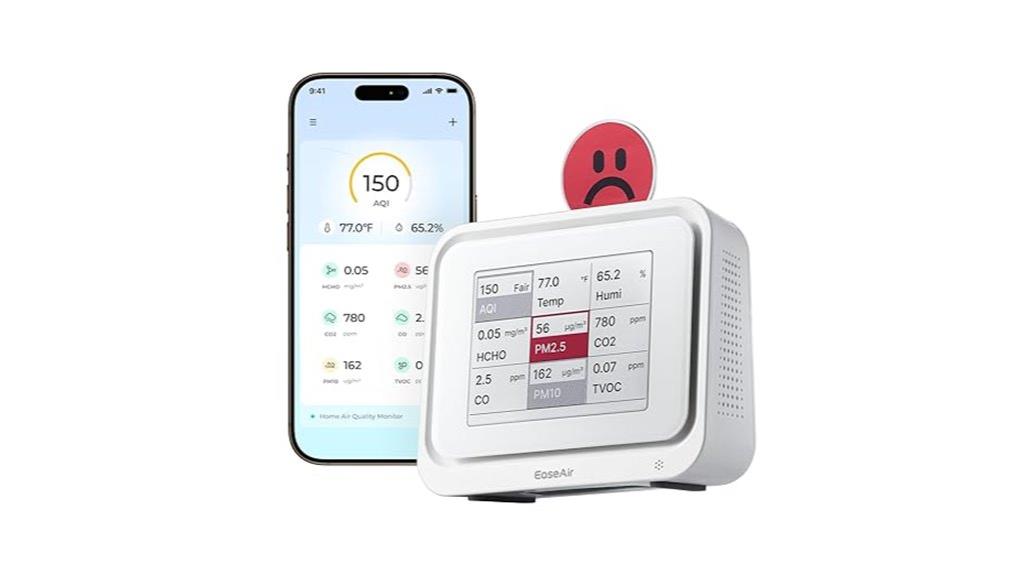
The Air Quality Monitor Indoor with WiFi and App Control is ideal for anyone seeking real-time, all-encompassing insights into their indoor environment. It measures CO₂, CO, PM2.5, PM10, formaldehyde, TVOC, humidity, and temperature, providing a thorough air quality assessment. Its advanced sensors deliver accurate, pollutant-specific data, even in complex conditions. The 4.2-inch E-Ink display shows clear visuals, with emoji indicators for quick understanding. WiFi connectivity enables remote monitoring through an app, with access to historical data and trend tracking. Its compact, eco-friendly design supports continuous power or long-lasting battery use, making it perfect for any space.
Best For: homeowners, office managers, and health-conscious individuals seeking comprehensive, real-time indoor air quality monitoring with remote access and detailed data analysis.
Pros:
- Provides accurate measurement of multiple indoor pollutants including CO2, CO, particulate matter, formaldehyde, and TVOC.
- Easy-to-read e-ink display with visual emoji indicators for instant understanding of air quality status.
- WiFi connectivity allows remote monitoring, trend tracking, and data access via app, supporting proactive air quality management.
Cons:
- May require an internet connection for full app functionality, limiting use in areas with poor WiFi.
- The device’s advanced sensors and features might come at a higher price point compared to simpler monitors.
- Battery life, while up to 30 days, depends on usage and power settings, which could be less in high-power modes.
12-in-1 Indoor Air Quality Monitor with Multiple Sensors
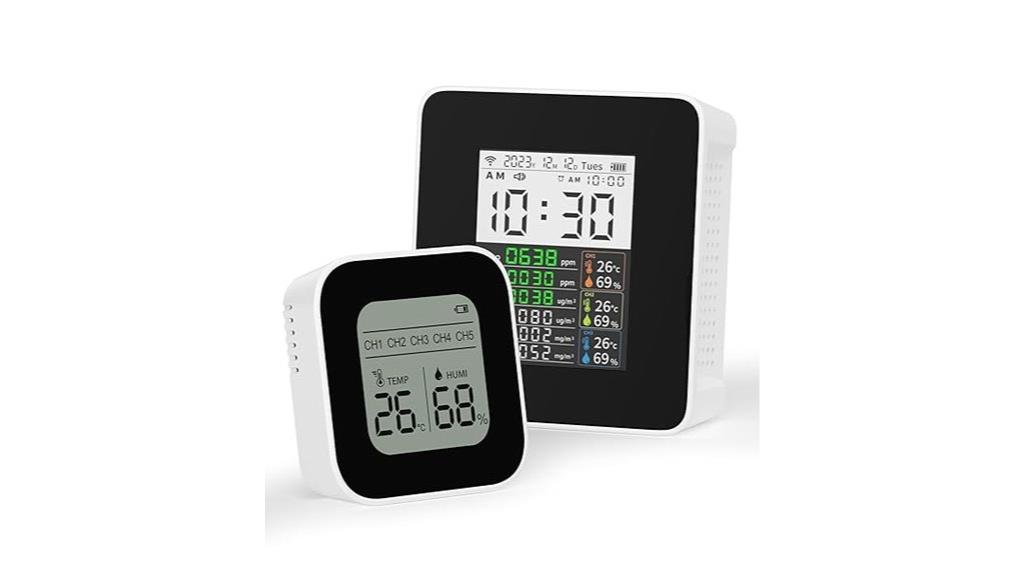
The 12-in-1 Indoor Air Quality Monitor stands out as the ideal choice for anyone who wants a detailed view of their indoor environment. It measures PM2.5, PM10, CO, CO2, HCHO, TVOC, temperature, and humidity, providing a thorough air quality snapshot. Its 2.8-inch LCD displays real-time data, and dual-area sensors monitor separate rooms simultaneously. Syncing with a smartphone app, it offers remote access, trend analysis, and customizable settings. Portable and powered by batteries or USB, it fits easily into homes, offices, or travel. This monitor helps detect pollutants early, empowering me to improve ventilation and maintain healthier indoor spaces effortlessly.
Best For: individuals seeking comprehensive and real-time indoor air quality monitoring to create healthier living or working environments.
Pros:
- Provides detailed measurements of multiple pollutants and environmental factors in one device.
- Supports remote monitoring and data analysis through a user-friendly smartphone app.
- Portable design with flexible power options makes it suitable for various settings and on-the-go use.
Cons:
- Requires purchase of batteries separately, which may add to initial costs.
- The complexity of multiple sensors may be overwhelming for casual or infrequent users.
- Some users may find the setup and app configuration slightly technical or time-consuming.
AirKnight Indoor Air Quality Monitor and Sensor
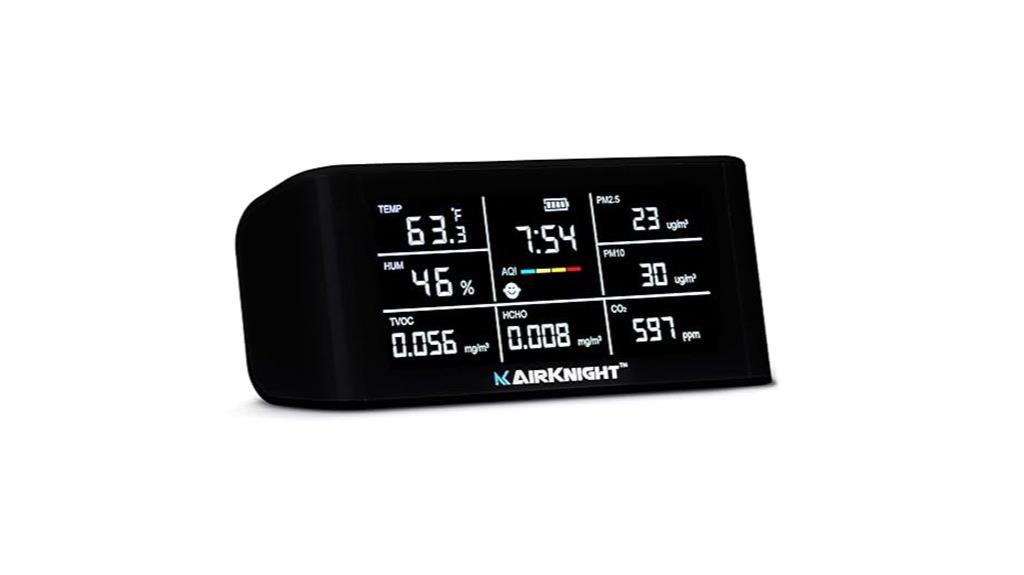
If you’re seeking a straightforward, portable air quality monitor that provides real-time data without relying on Wi-Fi or apps, the AirKnight Indoor Air Quality Monitor and Sensor is an excellent choice. This 10-in-1 device detects CO2, PM2.5, PM10, VOCs, formaldehyde, temperature, and humidity, all displayed on a large LCD screen. Its rechargeable battery offers portability, making it easy to move around your home, office, or vehicle. While the device is simple to use and includes helpful instructions, some users find calibration issues with the CO₂ sensor. Overall, it’s a reliable, user-friendly monitor perfect for quick, independent air quality assessments.
Best For: individuals seeking a portable, easy-to-use air quality monitor for quick assessments in homes, offices, or vehicles without relying on Wi-Fi or apps.
Pros:
- Provides real-time, comprehensive data on multiple indoor pollutants displayed on a large LCD screen.
- Battery-powered with rechargeable capacity, allowing for easy mobility and use in various environments.
- Simple plug-and-play setup with included instructions and an instructional video, making it user-friendly.
Cons:
- Potential calibration issues with the CO₂ sensor, leading to unreliable readings.
- Battery life can drain quickly, especially in cold weather or with prolonged use, limiting continuous monitoring.
- Lacks smart features, wireless connectivity, and the ability to wall-mount, restricting placement options.
9-in-1 Air Quality Monitor with CO2, TVOC, HCHO, PM2.5, PM1.0, PM10, Temperature, and Humidity

For anyone seeking a thorough view of indoor air quality, this 9-in-1 Air Quality Monitor stands out with its ability to measure CO2, TVOC, HCHO, PM levels, temperature, and humidity all at once. Its high-accuracy sensors include air semiconductor, infrared, and electrochemical types, delivering reliable readings up to 1PPM. The device features a large, backlit digital screen for easy reading, with customizable display modes and alarms. Powered by a long-lasting 2000mAh rechargeable battery, it’s portable and efficient. Ventilation holes ensure stable performance during continuous use, making it an excellent tool for maintaining healthy indoor environments.
Best For: individuals or organizations seeking comprehensive and accurate indoor air quality monitoring for health, safety, or environmental management.
Pros:
- Provides real-time detection of multiple air quality parameters including CO2, TVOC, HCHO, and particulate matter, offering a thorough indoor air assessment.
- Equipped with high-accuracy sensors and a clear, backlit digital display for easy reading and customization.
- Portable with a long-lasting rechargeable battery and effective heat dissipation for continuous, reliable operation.
Cons:
- The device may be relatively expensive compared to single-parameter monitors.
- Requires regular calibration to maintain optimal accuracy over time.
- The multiple sensors and advanced features might lead to a steeper learning curve for new users.
Temtop Air Quality Monitor for Indoor/Outdoor Pollution
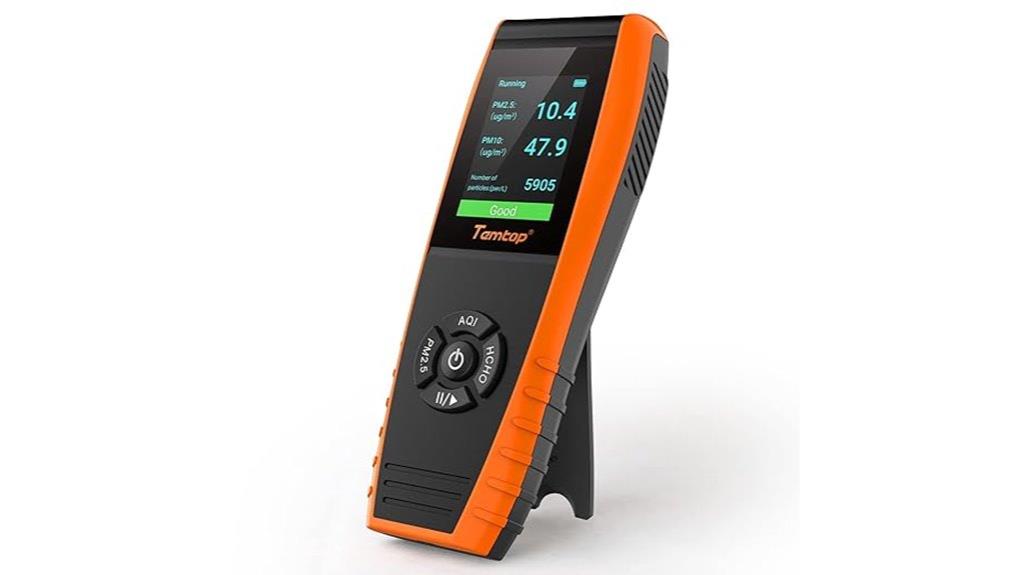
When monitoring both indoor and outdoor air quality, the Temtop Air Quality Monitor stands out thanks to its thorough measurement capabilities. It tracks PM2.5, PM10, formaldehyde, VOCs, temperature, humidity, and AQI with high accuracy sensors tested for reliability (R2 up to 0.999). The device supports up to three months of data recording, with easy export and visualization tools like histograms for trend analysis. Its durable laser sensors and user-friendly display make ongoing monitoring simple. While it doesn’t detect CO2, allergens, or mold, it offers precise, real-time insights into key pollutants, making it a valuable tool for maintaining healthier indoor and outdoor environments.
Best For: individuals seeking reliable, comprehensive indoor and outdoor air quality monitoring with easy data analysis and long-term recording capabilities.
Pros:
- Measures multiple pollutants including PM2.5, PM10, formaldehyde, VOCs, temperature, humidity, and AQI with high accuracy sensors.
- Supports up to 3 months of continuous data recording with export and trend visualization features.
- Durable laser sensors and a user-friendly display provide reliable, real-time air quality insights.
Cons:
- Does not detect CO2, allergens, or mold levels, limiting some aspects of indoor air quality assessment.
- Formaldehyde readings can be affected by substances like alcohol, air fresheners, and cleaning products.
- Lacks advanced features found in higher-end models, such as integrated connectivity or smart home integration.
Air Quality Monitor, 15-in-1 Smart Air Quality Tester
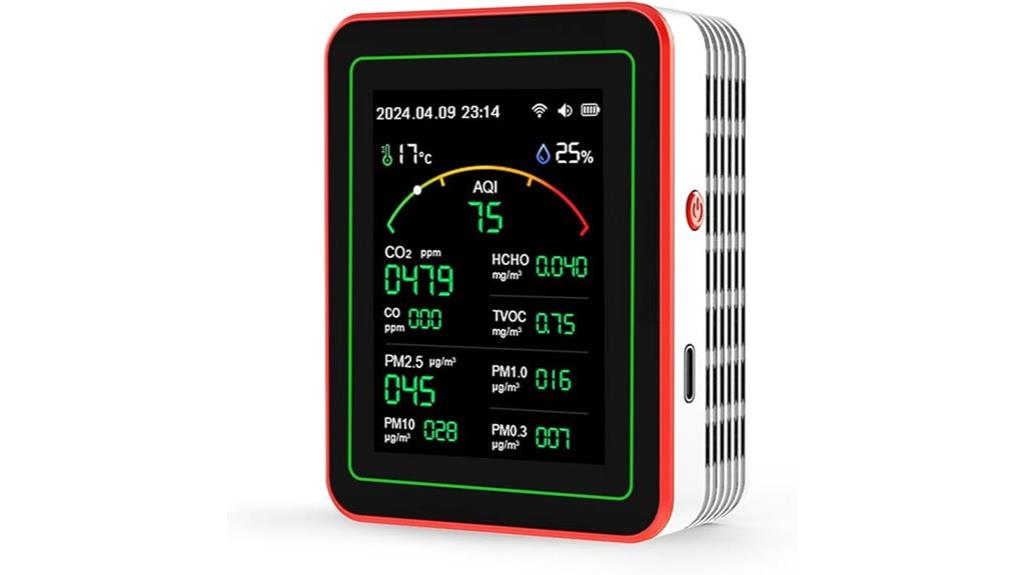
The Air Quality Monitor, 15-in-1 Smart Air Quality Tester, is an ideal choice for anyone who wants all-encompassing, real-time insights into indoor air conditions. It measures AQI, PM levels, CO2, CO, TVOC, HCHO, temperature, and humidity with high accuracy, thanks to its dual ventilation design. The large, colorful display shows 11 data points at once, making it easy to interpret air quality quickly. With mobile app connectivity, you can monitor remotely, set alarms, view trends, and receive notifications. Its portable, battery-powered design allows you to move it easily between rooms, offices, or vehicles for continuous air quality management.
Best For: individuals and families seeking comprehensive, real-time indoor air quality monitoring with remote access and alerts.
Pros:
- Measures 15 different air quality and environmental parameters for thorough monitoring.
- Large, colorful display with color-coded indicators for easy interpretation of data.
- Mobile app connectivity allows remote monitoring, trend analysis, and customizable alerts.
Cons:
- Battery life is limited to 6-7 hours of continuous use, requiring frequent recharging.
- Fully charging the device takes 3-4 hours, which may interrupt continuous monitoring.
- The device’s size and design may limit portability for some users needing ultra-compact options.
Factors to Consider When Choosing an Air Quality Sensor With Co₂, PM2.5, and TVOC

When choosing an air quality sensor, I focus on measurement accuracy standards to guarantee reliable results. I also consider the sensor technology type and how easily I can access real-time data. Additionally, I look at battery options and ease of use features to fit my specific needs.
Measurement Accuracy Standards
Selecting an air quality sensor with Co₂, PM2.5, and TVOC capabilities requires careful attention to measurement accuracy standards, which guarantee reliable data for health and safety decisions. Accuracy levels such as ±1 ppm for gases like CO₂ and formaldehyde ensure precise detection of pollutant concentrations. High-quality sensors adhere to calibration protocols aligned with industry or laboratory reference methods to maintain accuracy over time. Regulatory agencies and industry guidelines set minimum thresholds and testing procedures that sensors must meet to be considered trustworthy. Factors influencing accuracy include sensor type—electrochemical, infrared, or semiconductor—sensor drift, environmental conditions, and proper calibration. Validated sensors undergo periodic re-calibration and performance checks, preventing measurement deviations and ensuring consistent indoor air quality monitoring.
Sensor Technology Types
Choosing the right sensor technology is essential because different types offer varying levels of accuracy, response time, and maintenance needs. Electrochemical sensors excel in sensitivity and accuracy for gases like CO and TVOC but may need frequent calibration and have a limited lifespan. NDIR sensors are the gold standard for precise CO₂ detection, providing stability and long-term accuracy, especially in indoor environments. Semiconductor sensors are popular for PM2.5 and TVOC detection due to their affordability and compact size, though they can be less specific and more susceptible to interference. Each technology impacts the monitor’s reliability and performance. Understanding these differences helps you select a sensor that balances accuracy, durability, and maintenance, ensuring your indoor air quality stays ideal.
Real-Time Data Access
Access to real-time data is a key factor in effectively managing indoor air quality. It allows me to monitor conditions instantly, so I can respond quickly to pollution spikes from activities like cooking or ventilation issues. Sensors with live updates give continuous visibility into air quality, which is essential for catching sudden changes. Immediate data helps me make informed decisions, such as adjusting air purifiers or opening windows, to maintain a healthy environment. Many devices also feature instant alerts for pollutants like CO₂, PM2.5, and TVOC, preventing exposure to harmful levels. Having access to live data ensures I can track trends over time, understand patterns, and fine-tune my indoor air management strategies for better health and comfort.
Battery and Power Options
When evaluating air quality sensors with CO₂, PM2.5, and TVOC detection, understanding their power options is crucial for guaranteeing reliable performance and flexible placement. Consider if the sensor has a built-in rechargeable battery, replaceable batteries, or needs constant external power, as this impacts portability. Battery life varies from hours to days, depending on the device and power efficiency, so choose accordingly. Check if the sensor supports USB, Type-C, or proprietary chargers to ensure compatibility. Low-power modes or energy-saving features can extend battery life during prolonged use, which is especially important for outdoor or mobile applications. For remote or continuous monitoring, prioritize sensors with higher-capacity batteries or those designed for long-lasting operation without frequent recharging.
Ease of Use Features
To make certain you can effectively monitor air quality, it’s vital to select sensors with user-friendly features that simplify operation. Look for devices with large displays, simple controls, and clear visual indicators to make reading data easy. Prioritize models that offer quick setup and straightforward calibration, so you spend less time configuring and more time monitoring. Choose monitors with intuitive alert systems, like audible alarms or color-coded indicators, that promptly notify you of issues without complex settings. Features such as one-touch mute buttons, adjustable brightness, and clear instructions enhance daily usability. Additionally, devices supporting remote monitoring or smartphone integration allow convenient access to data and alerts, making it easier to stay informed even when you’re away. Ease of use is key to consistent and effective air quality management.
Connectivity Capabilities
Choosing an air quality sensor with reliable connectivity options is vital for effective monitoring of CO₂, PM2.5, and TVOC levels. I look for devices that support Wi-Fi, Bluetooth, or app integration, so I can access data remotely and stay informed anywhere. Seamless data transmission to smartphones, cloud platforms, or computers is essential for real-time alerts and analyzing historical trends. Compatibility with my existing smart home systems or automation platforms helps me integrate air quality monitoring into my daily routines. I also prioritize stable and secure wireless connections to prevent data loss or interruptions. Additionally, I check if the sensor receives firmware updates or software support via its connectivity features, ensuring the device stays current, performs at its best, and benefits from new features over time.
Maintenance and Calibration
Regular calibration is essential to keep air quality sensors accurate over time, preventing drift in measurements of CO₂, PM2.5, and TVOC levels. Without proper calibration, sensor readings can become unreliable, leading to inaccurate assessments of indoor air quality. Many sensors require periodic recalibration, often using reference gases or environmental conditions to adjust their measurements. Regular maintenance also involves cleaning dust, dirt, or residue from sensor surfaces, which can obstruct readings and degrade performance. Manufacturers typically recommend calibration intervals ranging from monthly to annually, depending on usage and environment. Proper maintenance and calibration are crucial for collecting dependable data, especially in settings with strict air quality standards or health-sensitive occupants. Investing in sensors with clear calibration guidelines simplifies ongoing upkeep and ensures consistent accuracy.
Frequently Asked Questions
How Accurate Are These Sensors Over Long-Term Use?
You’re wondering about long-term accuracy of these sensors, right? From what I’ve seen, quality sensors tend to stay reliable if you calibrate them regularly and keep them clean. Some drift over time, but manufacturers often include calibration features or recommend periodic checks. I find that consistent maintenance helps maintain their accuracy, making them dependable tools for monitoring indoor air quality over the long haul.
Do These Monitors Require Calibration or Maintenance?
Imagine these sensors are like vintage radios—sure, they need some tuning now and then. Most air quality monitors do require calibration and regular maintenance to stay accurate, especially over time. I recommend checking the manufacturer’s guidelines; some need periodic calibration, while others are pretty much maintenance-free. Staying on top of this guarantees your readings stay reliable, helping you breathe easier indoors.
Can They Detect Outdoor Air Quality Changes Indoors?
Indoor air quality sensors can detect outdoor air changes if they’re sensitive enough and properly positioned near vents or windows. I’ve found that some models effectively pick up outdoor pollutants that seep indoors, helping me monitor air quality fluctuations. Just remember, placement matters—placing sensors near potential entry points guarantees you get accurate readings of outdoor influences on your indoor environment.
Are These Sensors Compatible With Smart Home Systems?
You’re wondering if these sensors work with smart home systems? I can tell you, many modern air quality sensors are designed for compatibility. They often integrate seamlessly with popular platforms like Alexa, Google Home, or Apple HomeKit. This allows me to monitor air quality remotely and even automate ventilation or air purifiers. Before buying, I double-check the product specs to make certain they’ll connect smoothly with my existing smart home setup.
What Are the Power Options for Continuous Monitoring?
When it comes to continuous monitoring, I look for sensors with versatile power options. Many models run on AC power, ensuring constant operation, while some offer rechargeable batteries or replaceable batteries for flexibility. Solar-powered options are also available for eco-conscious setups. I prefer sensors that automatically switch between power sources or have low power consumption, so I’m always aware of indoor air quality without interruptions.
Conclusion
Choosing the right air quality sensor can truly transform your indoor environment, making it healthier and safer. With so many options like the Bonoch 16-in-1 or the Temtop monitor, you’re spoiled for choice. But isn’t it worth investing in a device that keeps your air clean and your family safe? Take your time, consider your needs, and breathe easier knowing you’ve made the best choice for better indoor air in 2025.
